Metal-Catalyzed Carbon Foams Synthesized from Glucose as Highly Efficient Electromagnetic Absorbers
Abstract
:1. Introduction
2. Experimental Section and Characterization
2.1. Materials
2.2. Synthesis of Metal-Containing, Glucose-Derived Carbon Foam (GCF-M)
2.3. Characterization
2.4. EM Parameter Measurements
3. Results and Discussion
4. Conclusions
Author Contributions
Funding
Institutional Review Board Statement
Informed Consent Statement
Data Availability Statement
Conflicts of Interest
References
- Wu, N.; Hu, Q.; Wei, R.; Mai, X.; Naik, N.; Pan, D.; Guo, Z.; Shi, Z. Review on the electromagnetic interference shielding properties of carbon based materials and their novel composites: Recent progress, challenges and prospects. Carbon 2021, 176, 88–105. [Google Scholar] [CrossRef]
- Malyapa, R.S.; Ahern, E.W.; Straube, W.L.; Moros, E.G.; Pickard, W.F.; Roti, J.L.R. Measurement of DNA damage after exposure to electromagnetic radiation in the cellular phone communication frequency band (835.62 and 847.74 MHz). Radiat. Res. 1997, 148, 618–627. [Google Scholar] [CrossRef] [PubMed]
- Malyapa, R.S.; Ahern, E.W.; Straube, W.L.; Moros, E.G.; Pickard, W.F.; Roti, J.L.R. Measurement of DNA damage after exposure to 2450 MHz electromagnetic radiation. Radiat. Res. 1997, 148, 608–617. [Google Scholar] [CrossRef] [PubMed]
- Changdar, A.; Chakraborty, S.S. Laser processing of metal foam—A review. J. Manuf. Process. 2021, 61, 208–225. [Google Scholar] [CrossRef]
- Hassan, A.; Alnaser, I.A. A Review of Different Manufacturing Methods of Metallic Foams. ACS Omega 2024, 9, 6280–6295. [Google Scholar] [CrossRef] [PubMed]
- Tarlochan, F. Sandwich Structures for Energy Absorption Applications: A Review. Materials 2021, 14, 4731. [Google Scholar] [CrossRef] [PubMed]
- Sultanov, F.; Daulbayev, C.; Bakbolat, B.; Daulbayev, O. Advances of 3D graphene and its composites in the field of microwave absorption. Adv. Colloid Interface Sci. 2020, 285, 102281. [Google Scholar] [CrossRef]
- Chen, H.; Ma, W.; Huang, Z.; Zhang, Y.; Huang, Y.; Chen, Y. Graphene-Based Materials toward Microwave and Terahertz Absorbing Stealth Technologies. Adv. Opt. Mater. 2019, 7, 1801318. [Google Scholar] [CrossRef]
- Choi, W.-H.; Kwak, B.-S.; Kweon, J.-H.; Nam, Y.-W. Radar-absorbing foam-based sandwich composite with electroless nickel-plated glass fabric. Compos. Struct. 2020, 243, 112252. [Google Scholar] [CrossRef]
- Li, J.; Wang, A.; Qin, J.; Zhang, H.; Ma, Z.; Zhang, G. Lightweight polymethacrylimide@copper/nickel composite foams for electromagnetic shielding and monopole antennas. Compos. Part A-Appl. Sci. Manuf. 2021, 140, 106144. [Google Scholar] [CrossRef]
- Deng, L.; Shu, R.; Zhang, J. Fabrication of ultralight nitrogen-doped reduced graphene oxide/nickel ferrite composite foams with three-dimensional porous network structure as ultrathin and high-performance microwave absorbers. J. Colloid Interface Sci. 2022, 614, 110–119. [Google Scholar] [CrossRef] [PubMed]
- Lv, X.; Cao, M.; Li, Y.; Li, X.; Li, Q.; Tang, R.; Wang, Q.; Duan, Y. A new absorbing foam concrete: Preparation and microwave absorbing properties. Adv. Concr. Constr. 2015, 3, 103–111. [Google Scholar]
- Deng, G.; Yang, Y.; Zhou, Q.; Lei, Y.; Yue, L.; Yang, T. Lightweight and broadband electromagnetic wave absorbing foamed cement-based composites incorporated with hybrid dielectric fibers. Constr. Build. Mater. 2022, 327, 126931. [Google Scholar] [CrossRef]
- Li, H.; Wei, M.; Song, Y.; Wang, R.; Liu, F.; Liu, F. Design and optimization of double-layer structure for improved electromagnetic wave absorbing characteristic of single-layer foam cement-based materials containing carbon black. J. Build. Eng. 2024, 89, 109319. [Google Scholar] [CrossRef]
- Wang, T.G.; Gong, J.; Du, H.; Liu, J.G.; Sun, C.; Wen, L.S. Study on electromagnetic wave transmission performances of ultra-thin metallic films. Acta Metall. Sin. 2005, 41, 814–818. [Google Scholar]
- Xu, Z.; Hao, H. Electromagnetic interference shielding effectiveness of aluminum foams with different porosity. J. Alloys Compd. 2014, 617, 207–213. [Google Scholar] [CrossRef]
- Hunjra, M.A.M.; Fakhar, M.A.; Naveed, K.; Subhani, T. Polyurethane foam-based radar absorbing sandwich structures to evade detection. J. Sandw. Struct. Mater. 2017, 19, 647–658. [Google Scholar] [CrossRef]
- Ghosh, S.; Ganguly, S.; Remanan, S.; Mondal, S.; Jana, S.; Maji, P.K.; Singha, N.; Das, N.C. Ultra-light weight, water durable and flexible highly electrical conductive polyurethane foam for superior electromagnetic interference shielding materials. J. Mater. Sci.-Mater. Electron. 2018, 29, 10177–10189. [Google Scholar] [CrossRef]
- Moghaddam, S.T.; Naimi-Jamal, M.R. Reinforced magnetic polyurethane rigid (PUR) foam nanocomposites and investigation of thermal, mechanical, and sound absorption properties. J. Thermoplast. Compos. Mater. 2019, 32, 1224–1241. [Google Scholar] [CrossRef]
- Jia, Z.; Zhang, M.; Liu, B.; Wang, F.; Wei, G.; Su, Z. Graphene Foams for Electromagnetic Interference Shielding: A Review. ACS Appl. Nano Mater. 2020, 3, 6140–6155. [Google Scholar] [CrossRef]
- Panahi-Sarmad, M.; Noroozi, M.; Abrisham, M.; Eghbalinia, S.; Teimoury, F.; Bahramian, A.R.; Dehghan, P.; Sadri, M.; Goodarzi, V. A Comprehensive Review on Carbon-Based Polymer Nanocomposite Foams as Electromagnetic Interference Shields and Piezoresistive Sensors. ACS Appl. Electron. Mater. 2020, 2, 2318–2350. [Google Scholar] [CrossRef]
- Wang, K.; Zhou, C.; Zhou, Y.; Fan, Y.; Chen, J.; Hui, L.; Zhang, X.; Qin, J. Design and research of high-performance electromagnetic interference shielding GO/NiNCs/PMMA microcellular foams. J. Appl. Polym. Sci. 2023, 140, 54070. [Google Scholar] [CrossRef]
- Wang, P.; Deng, G.; Zhu, H.; Yin, J.; Xiong, X.; Zhang, H. Effect of Pyrolytic Carbon Interface Thickness on Conductivity and Tribological Properties of Copper Foam/Carbon Composite. Appl. Compos. Mater. 2021, 28, 219–233. [Google Scholar] [CrossRef]
- Liu, X.; Liu, H.; Xu, H.; Xie, W.; Li, M.; Liu, J.; Liu, G.; Weidenkaff, A.; Riedel, R. Natural wood templated hierarchically cellular NbC/Pyrolytic carbon foams as Stiff, lightweight and High-Performance electromagnetic shielding materials. J. Colloid Interface Sci. 2022, 606, 1543–1553. [Google Scholar] [CrossRef] [PubMed]
- Kong, L.; Luo, S.; Zhang, S.; Zhang, G.; Liang, Y. Ultralight pyrolytic carbon foam reinforced with amorphous carbon nanotubes for broadband electromagnetic absorption. Int. J. Miner. Metall. Mater. 2023, 30, 570–580. [Google Scholar] [CrossRef]
- Xu, X.; Zhang, D.; Wang, Z.; Zuo, S.; Yuan, J.; Hu, R.; Liu, J. Ultrafine ZnS nanoparticles in the nitrogen-doped carbon matrix for long-life and high-stable potassium-ion batteries. ACS Appl. Mater. Interfaces 2021, 13, 11007–11017. [Google Scholar] [CrossRef] [PubMed]
- Liu, W.; Shao, Q.; Ji, G.; Liang, X.; Cheng, Y.; Quan, B.; Du, Y. Metal–organic-frameworks derived porous carbon-wrapped Ni composites with optimized impedance matching as excellent lightweight electromagnetic wave absorber. Chem. Eng. J. 2017, 313, 734–744. [Google Scholar] [CrossRef]
- Sun, J.; Yu, X.; Zhao, S.; Chen, H.; Tao, K.; Han, L. Solvent-Controlled Morphology of Amino-Functionalized Bimetal Metal–Organic Frameworks for Asymmetric Supercapacitors. Inorg. Chem. 2020, 59, 11385–11395. [Google Scholar] [CrossRef] [PubMed]
- Zhou, L.; Yang, C.; Wen, J.; Fu, P.; Zhang, Y.; Sun, J.; Wang, H.; Yuan, Y. Soft-template assisted synthesis of Fe/N-doped hollow carbon nanospheres as advanced electrocatalysts for the oxygen reduction reaction in microbial fuel cells. J. Mater. Chem. A 2017, 5, 19343–19350. [Google Scholar] [CrossRef]
- Du, B.; Qian, J.; Hu, P.; He, C.; Cai, M.; Wang, X.; Shui, A. Fabrication of C-doped SiC nanocomposites with tailoring dielectric properties for the enhanced electromagnetic wave absorption. Carbon 2020, 157, 788–795. [Google Scholar] [CrossRef]
- Hou, C.; Cheng, J.; Zhang, H.; Lu, Z.; Yang, X.; Zheng, G.; Zhang, D.; Cao, M. Biomass-derived carbon-coated WS2 core-shell nanostructures with excellent electromagnetic absorption in C-band. Appl. Surf. Sci. 2022, 577, 151939. [Google Scholar] [CrossRef]
- Tang, N.; Zhong, W.; Au, C.; Yang, Y.; Han, M.; Lin, K.; Du, Y. Synthesis, microwave electromagnetic, and microwave absorption properties of twin carbon nanocoils. J. Phys. Chem. C 2008, 112, 19316–19323. [Google Scholar] [CrossRef]
- Luo, K.; Yin, X.; Yuan, X.; Zhang, Y.; Zhang, L. Electromagnetic wave absorption properties of graphene modified with carbon nanotube/poly(dimethyl siloxane) composites. Carbon 2014, 73, 185–193. [Google Scholar]
- Wang, X.; Cao, W.; Cao, M.; Yuan, J. Assembling Nano–Microarchitecture for Electromagnetic Absorbers and Smart Devices. Adv. Mater. 2020, 32, 2002112. [Google Scholar] [CrossRef] [PubMed]
- Zhou, C.; Zhao, S.; Meng, H.; Han, Y.; Jiang, Q.; Wang, B.; Shi, X.; Zhang, W.; Zhang, L.; Zhang, R. RuCoOx Nanofoam as a High-Performance Trifunctional Electrocatalyst for Rechargeable Zinc–Air Batteries and Water Splitting. Nano Lett. 2021, 21, 9633–9641. [Google Scholar] [CrossRef] [PubMed]
- Han, F.; Qian, O.; Chen, B.; Tang, H.; Wang, M. Sugar blowing-assisted reduction and interconnection of graphene oxide into three-dimensional porous graphene. J. Alloys Compd. 2018, 730, 386–391. [Google Scholar] [CrossRef]
- Varila, T.; Romar, H.; Lassi, U. Catalytic Effect of Transition Metals (Copper, Iron, and Nickel) on the Foaming and Properties of Sugar-Based Carbon Foams. Top. Catal. 2019, 62, 764–772. [Google Scholar] [CrossRef]
- Fan, M.; Cui, J.; Wu, J.; Vajtai, R.; Sun, D.; Ajayan, P.M. Improving the Catalytic Activity of Carbon-Supported Single Atom Catalysts by Polynary Metal or Heteroatom Doping. Small 2020, 16, 1906782. [Google Scholar] [CrossRef]
- Zhang, X.; Shi, Y.; Xu, J.; Ouyang, Q.; Chen, Y. Identification of the Intrinsic Dielectric Properties of Metal Single Atoms for Electromagnetic Wave Absorption. Nano-Micro Lett. 2022, 14, 27. [Google Scholar] [CrossRef]
- Zhao, Z.; Duan, L.; Zhao, Y.; Wang, L.; Zhang, J.; Bu, F.; Sun, Z.; Zhang, T.; Liu, M.; Chen, H.; et al. Constructing Unique Mesoporous Carbon Superstructures via Monomicelle Interface Confined Assembly. J. Am. Chem. Soc. 2022, 144, 11767–11777. [Google Scholar] [CrossRef]
- Fang, J.; Lv, H.; Zhao, B.; Liu, Z.; Li, X.; Xu, C.; Zhang, R.; Zhang, H.; Liu, X.; Zhang, X.; et al. Selective assembly of magnetic nano-antenna for electromagnetic dissipation. J. Mater. Chem. A 2022, 10, 10909–10915. [Google Scholar] [CrossRef]
- Ling, A.; Tan, G.; Man, Q.; Lou, Y.; Chen, S.; Gu, X.; Li, R.W.; Pan, J.; Liu, X. Broadband microwave absorbing materials based on MWCNTs’ electromagnetic wave filtering effect. Composites 2019, 171, 214–221. [Google Scholar] [CrossRef]
- Wei, B.; Zhou, J.; Yao, Z.; Haidry, A.A.; Chen, W. The effect of Ag nanoparticles content on dielectric and microwave absorption properties of β-SiC. Ceram. Int. 2019, 46, 5788–5798. [Google Scholar] [CrossRef]
- Liu, X.; Nie, X.; Yu, R.; Feng, H. Design of dual-frequency electromagnetic wave absorption by interface modulation strategy. Chem. Eng. J. 2017, 334, 153–161. [Google Scholar]
- Lv, H.; Guo, Y.; Wu, G.; Ji, G.; Zhao, Y.; Xu, Z.J. Interface Polarization Strategy to Solve Electromagnetic Wave Interference Issue. ACS Appl Mater Interfaces 2017, 9, 5660–5668. [Google Scholar] [CrossRef] [PubMed]
- Wu, X.; Liu, K.; Ding, J.; Zheng, B.; Gao, F.; Qian, K.; Ma, Y.; Feng, Y.; Chen, L.; Zhang, P.; et al. Construction of Ni-based alloys decorated sucrose-derived carbon hybrid towards: Effective microwave absorption application. Adv. Compos. Hybrid Mater. 2022, 5, 2260–2270. [Google Scholar] [CrossRef]
- Wang, H.; Zhang, X.; Tang, Y.; Rong, W.; Zhao, J.; Fan, C.; Zhang, Z.; Sun, Z.; Yang, Y.; Lin, Y. Using Silk-derived Magnetic Carbon Nanocomposites as Highly Efficient Nanozymes and Electromagnetic Absorbing Agents. Chin. Chem. Lett. 2022, 34, 108084. [Google Scholar] [CrossRef]
- Zhang, Y.; Huang, Y.; Chen, H.; Huang, Z.; Yang, Y.; Xiao, P.; Zhou, Y.; Chen, Y. Composition and structure control of ultralight graphene foam for high-performance microwave absorption. Carbon 2016, 105, 438–447. [Google Scholar] [CrossRef]
- Ma, J.; Li, W.; Fan, Y.; Yang, J.; Yang, Q.; Wang, J.; Luo, W.; Zhou, W.; Nomura, N.; Wang, L.; et al. Ultrathin and light-weight graphene aerogel with precisely tunable density for highly efficient microwave absorbing. ACS Appl. Mater. Interfaces 2019, 11, 46386–46396. [Google Scholar] [CrossRef]
- Zhang, X.-H.; Wei, C.-Y.; Zha, L.-L.; Chen, J.-W.; Wang, J.-W.; Yu, H.-L.; Wu, J.-H. Facile One-Pot Synthesis of Polypyrrole-Coated Magnetic Montmorillonite for Enhanced Microwave Absorption and Sunlight-Induced Heat Generation. J. Alloys Compd. 2024, 971, 172676. [Google Scholar] [CrossRef]
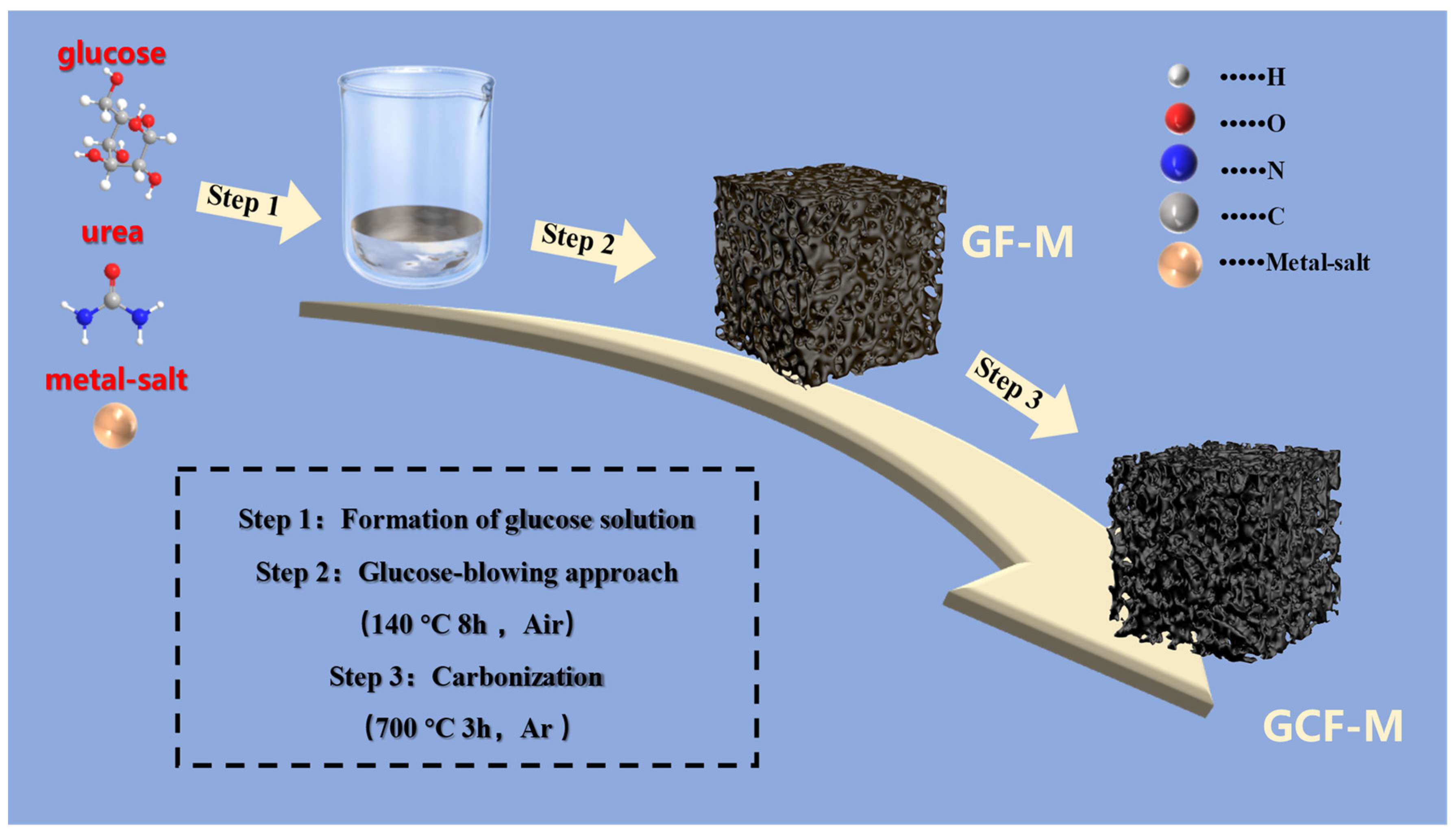
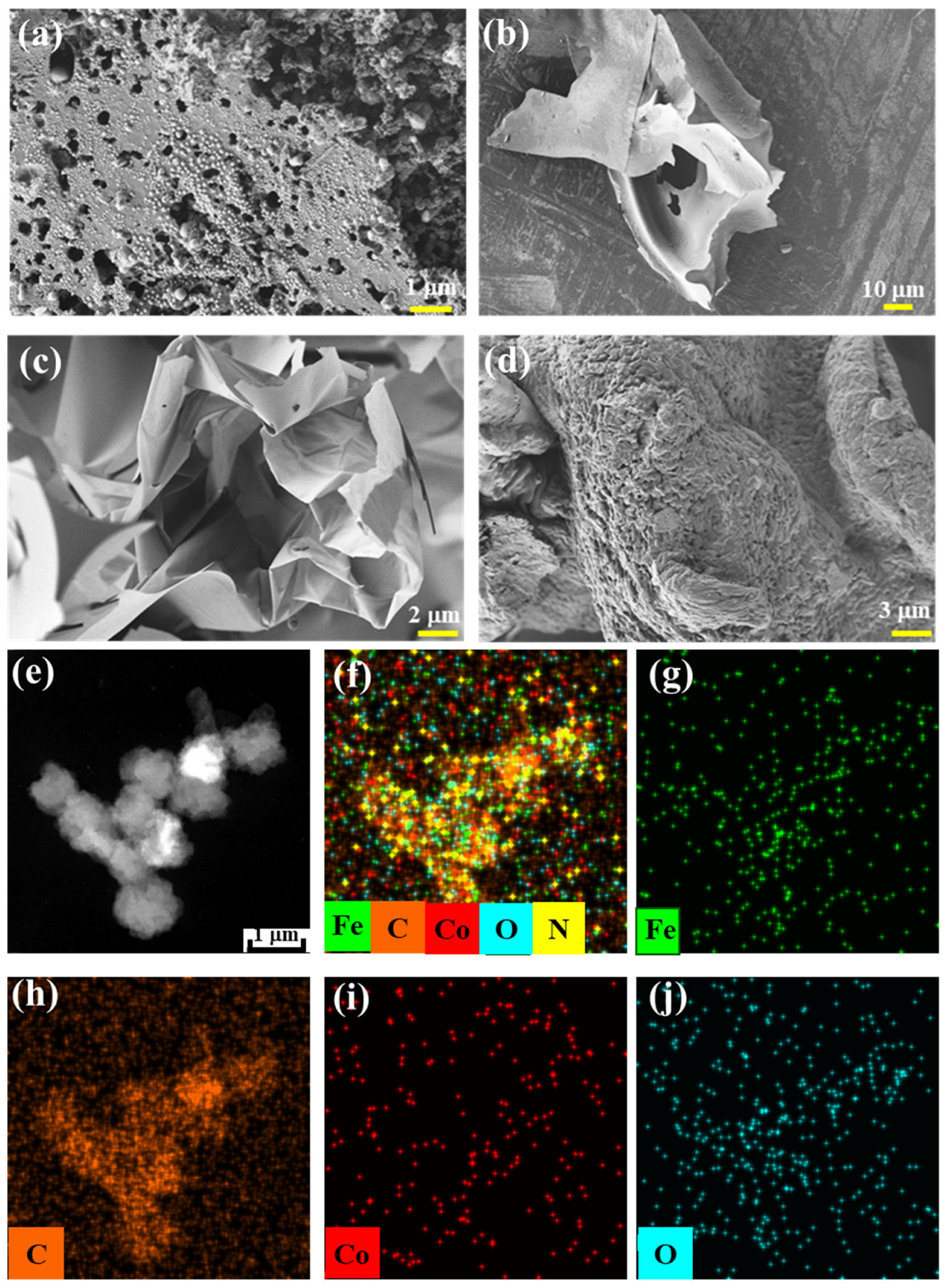
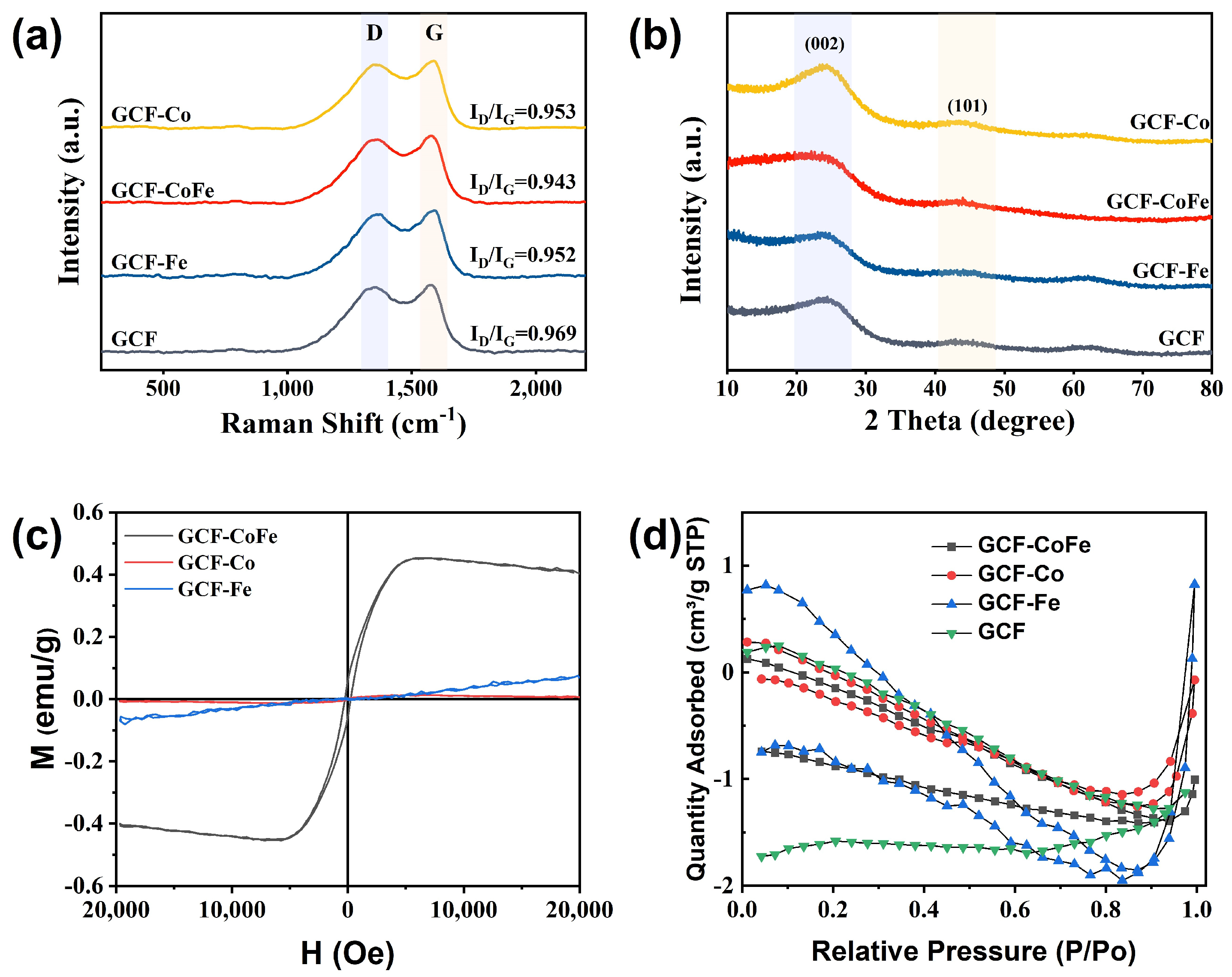
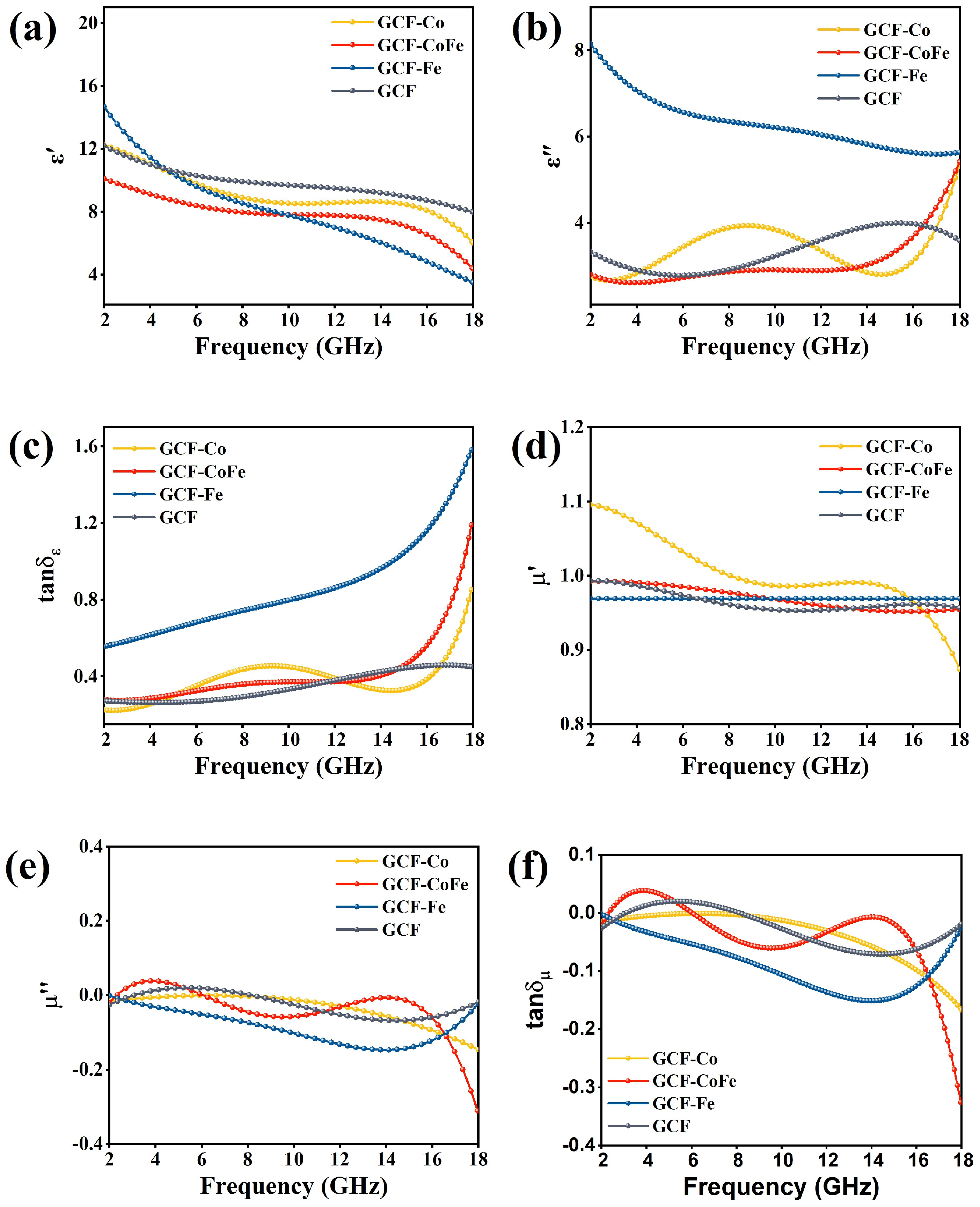
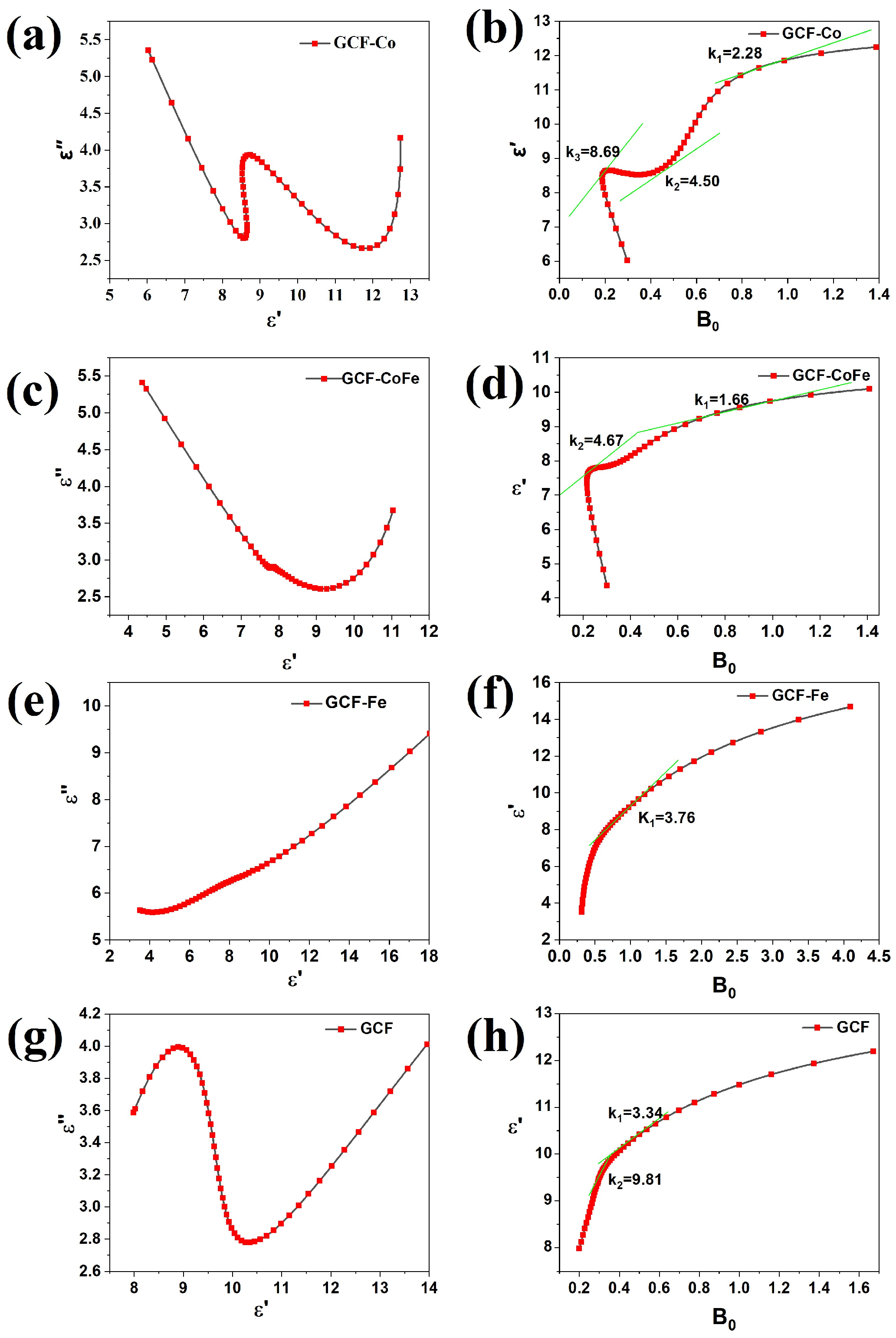
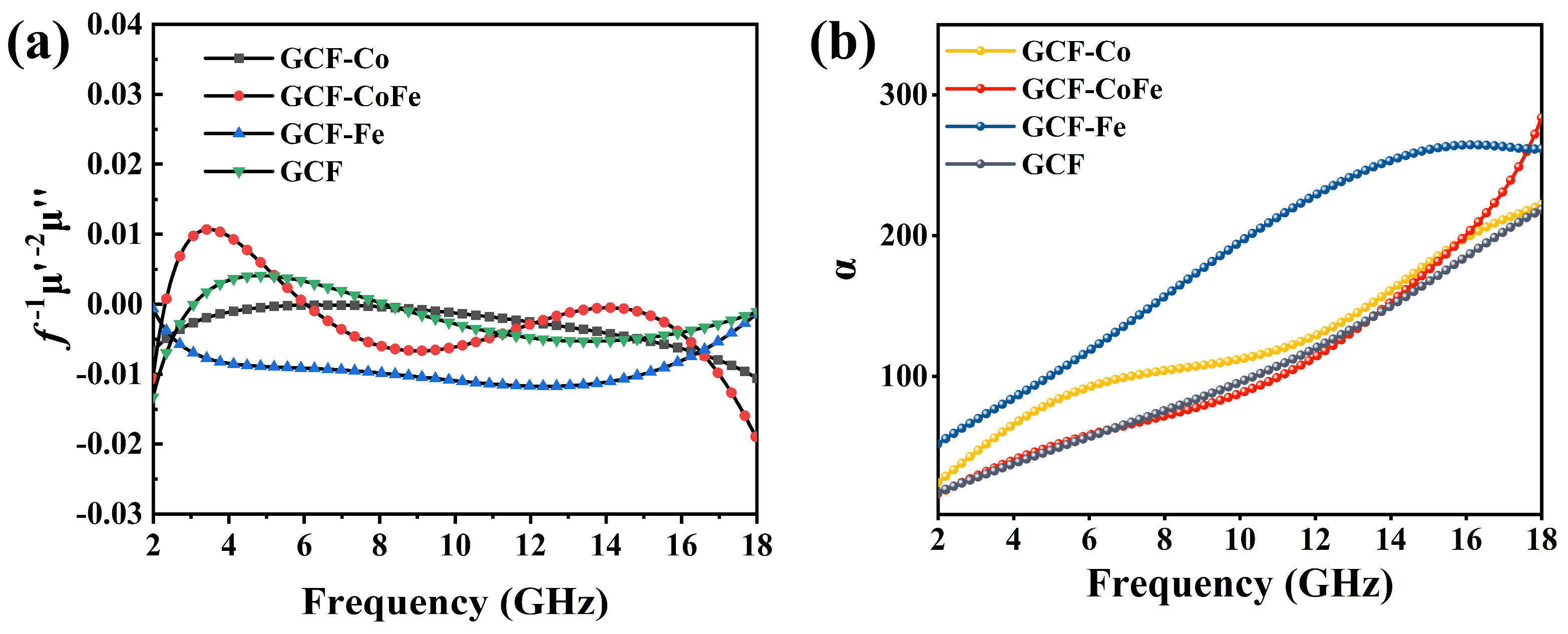
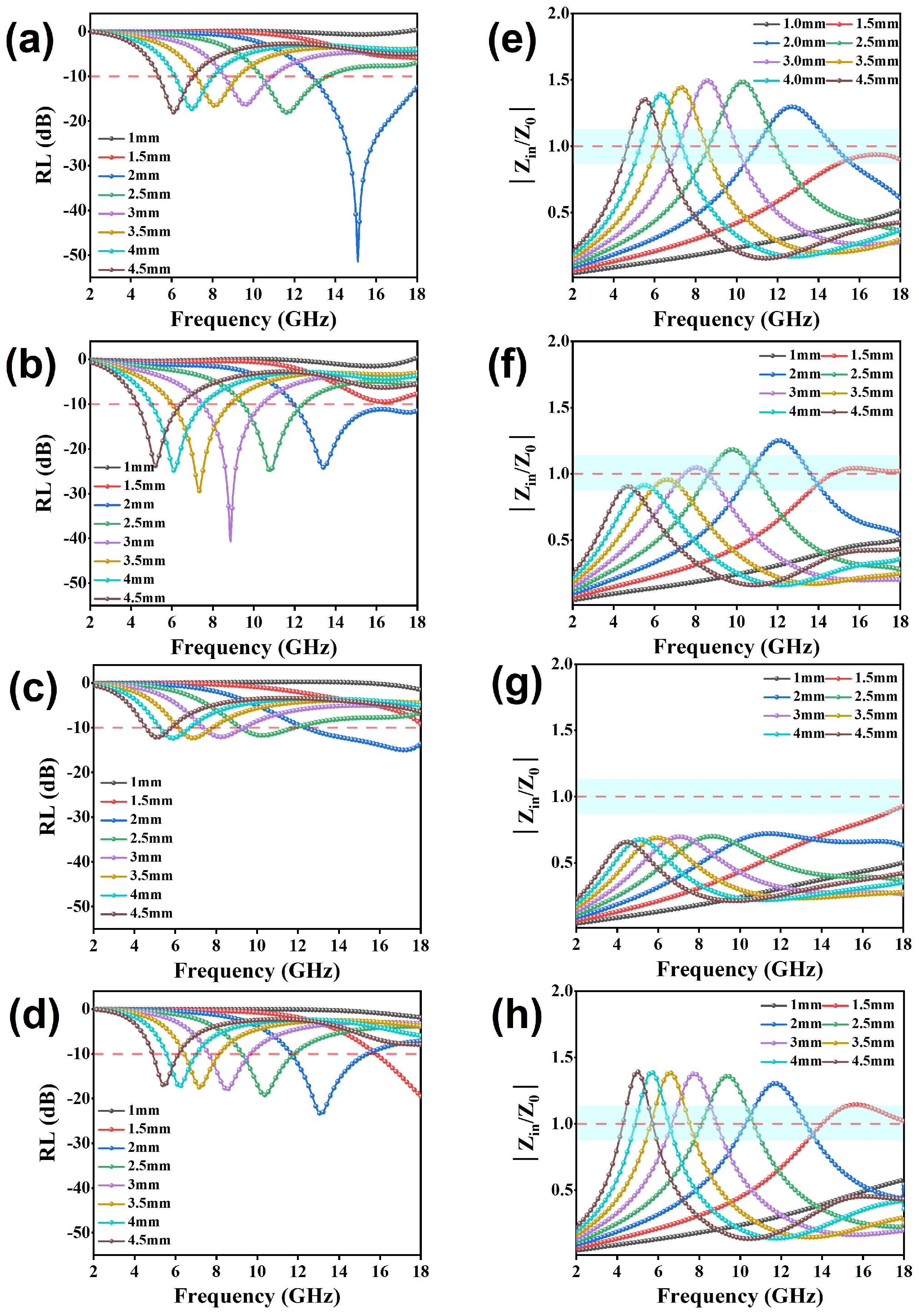
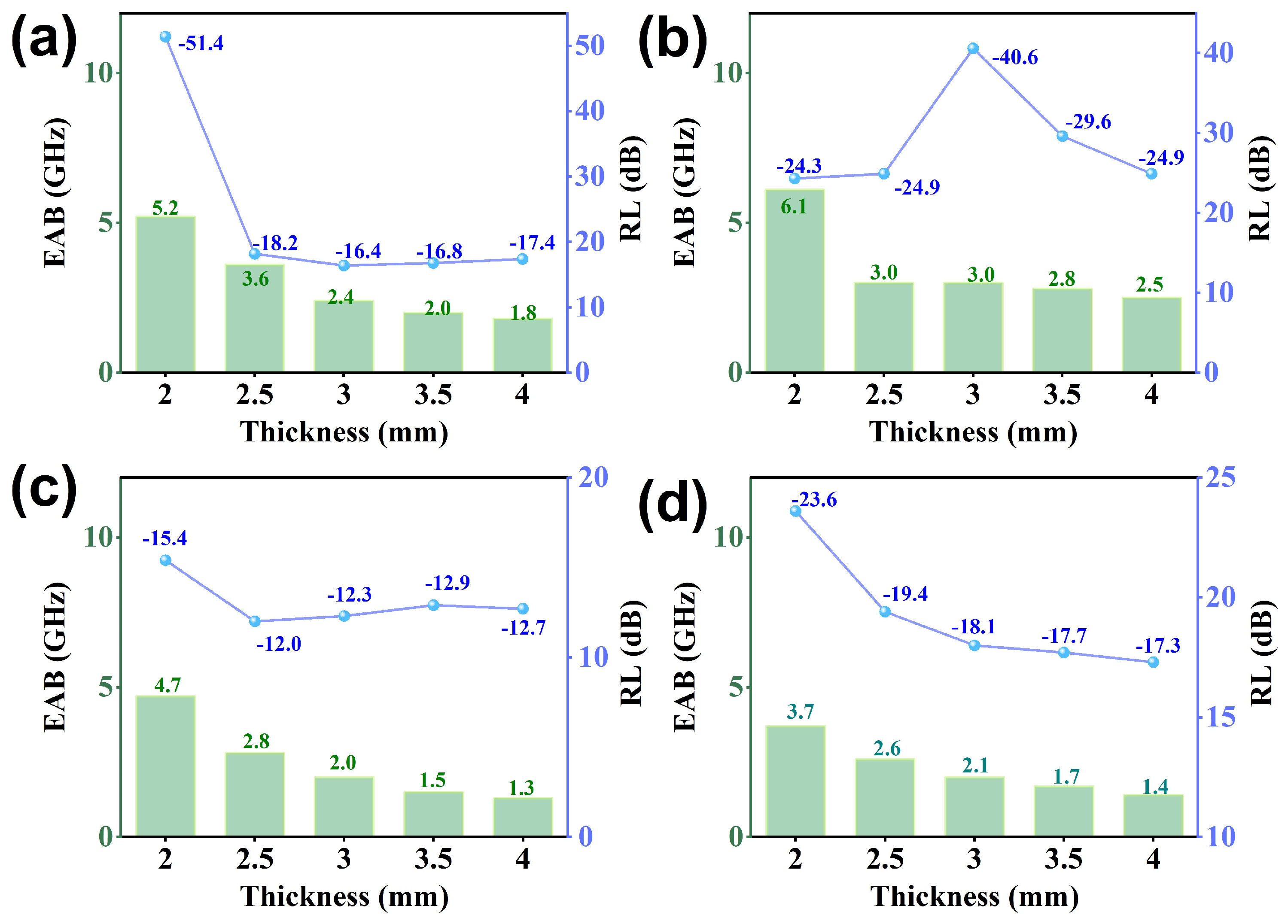
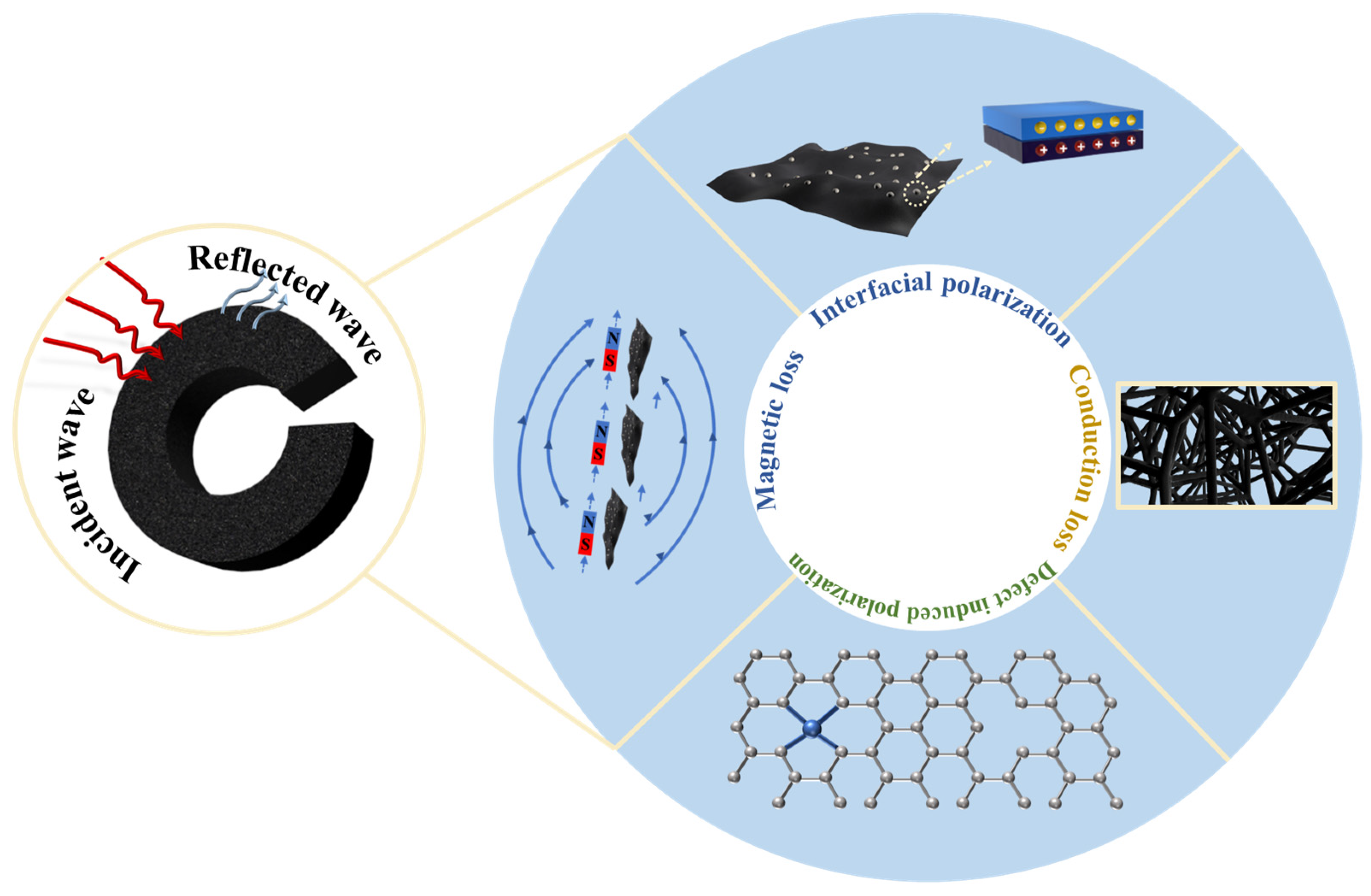
| Samples | Thickness mm | RLmin/dB (Corresponding Frequency GHz) | Frequency Range/GHz | EAB/GHz | Ref. |
|---|---|---|---|---|---|
| Co–Ni/C composite | 3.3 | −34.3 (~9.6) | 8.00–12.24 | 4.24 | [46] |
| Fe–Ni/C composite | 5.7 | −42.3 (17.1) | 15.20–18.00 | 2.80 | [46] |
| Fe-N-CNS | 1.0 | −37.33 (11.41) | 9.44–16.17 | 6.73 | [47] |
| Graphene foam | 10 | −34.0 (13.1) | ~3.30–18.00 | 14.7 | [48] |
| Graphene Aerogel | 1.14 | −50.3 (24.29) | 21.23–26.50 | 5.27 | [49] |
| Fe3O4@C/GA | 0.99 | −54.0 (19.87) | 18.00–24.50 | 6.50 | [49] |
| MMT/Fe3O4/PPy | 3.5 | −41.35 (11.52) | 6.47–15.39 | 8.92 | [50] |
| GCF-Co | 2.0 | −24.3 (13.40) | 12.80–18.00 | 6.10 | This work |
| GCF-CoFe | 2.0 | −51.4 (15.11) | 12.80–18.00 | 5.20 | This work |
| GCF-Fe | 2.0 | −15.4 (17.14) | 13.3–18.00 | 4.7 | This work |
Disclaimer/Publisher’s Note: The statements, opinions and data contained in all publications are solely those of the individual author(s) and contributor(s) and not of MDPI and/or the editor(s). MDPI and/or the editor(s) disclaim responsibility for any injury to people or property resulting from any ideas, methods, instructions or products referred to in the content. |
© 2024 by the authors. Licensee MDPI, Basel, Switzerland. This article is an open access article distributed under the terms and conditions of the Creative Commons Attribution (CC BY) license (https://creativecommons.org/licenses/by/4.0/).
Share and Cite
Liu, G.-H.; Wei, C.-Y.; Huang, T.; Wang, F.; Chang, J.-F.; Sun, Q.; Zhang, X.-H. Metal-Catalyzed Carbon Foams Synthesized from Glucose as Highly Efficient Electromagnetic Absorbers. Materials 2024, 17, 3488. https://doi.org/10.3390/ma17143488
Liu G-H, Wei C-Y, Huang T, Wang F, Chang J-F, Sun Q, Zhang X-H. Metal-Catalyzed Carbon Foams Synthesized from Glucose as Highly Efficient Electromagnetic Absorbers. Materials. 2024; 17(14):3488. https://doi.org/10.3390/ma17143488
Chicago/Turabian StyleLiu, Guan-Hong, Chuan-Ying Wei, Ting Huang, Fei Wang, Jiang-Fan Chang, Qian Sun, and Xian-Hui Zhang. 2024. "Metal-Catalyzed Carbon Foams Synthesized from Glucose as Highly Efficient Electromagnetic Absorbers" Materials 17, no. 14: 3488. https://doi.org/10.3390/ma17143488




